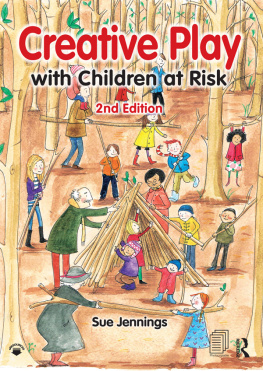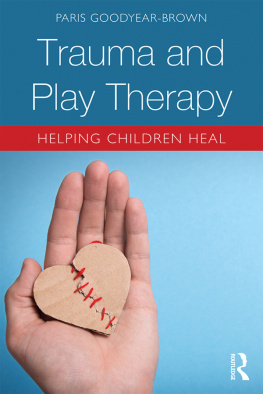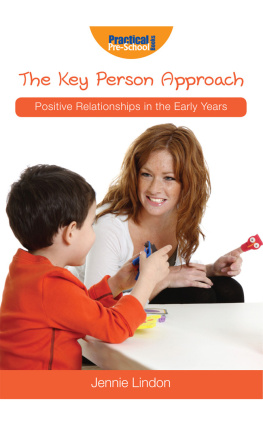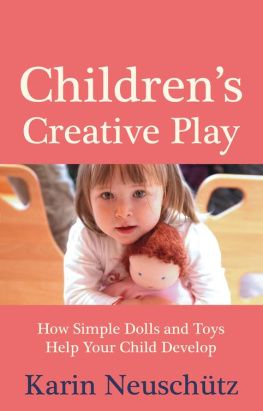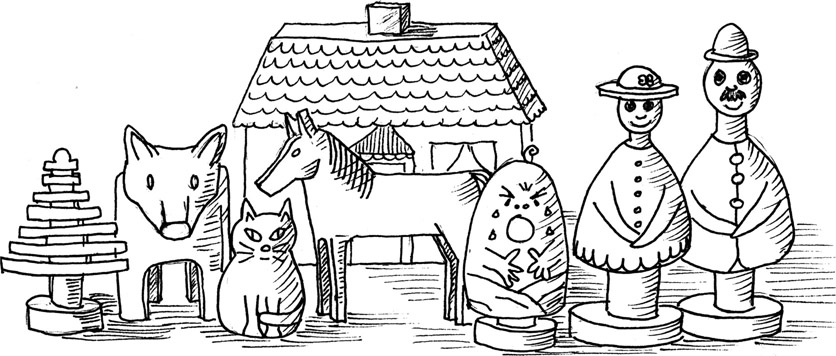Second edition published 2017
by Routledge
2 Park Square, Milton Park, Abingdon, Oxon OX14 4RN
and by Routledge
711 Third Avenue, New York, NY 10017
Routledge is an imprint of the Taylor & Francis Group, an informa business
2017 Sue Jennings
The right of Sue Jennings to be identified as author of this work has been asserted by her in accordance with sections 77 and 78 of the Copyright, Designs and Patents Act 1988.
All rights reserved. No part of this book may be reprinted or reproduced or utilised in any form or by any electronic, mechanical, or other means, now known or hereafter invented, including photocopying and recording, or in any information storage or retrieval system, without permission in writing from the publishers.
Trademark notice: Product or corporate names may be trademarks or registered trademarks, and are used only for identification and explanation without intent to infringe.
First edition published by Speechmark Publishing 2005
British Library Cataloguing-in-Publication Data
A catalogue record for this book is available from the British Library
Library of Congress Cataloging-in-Publication Data
A catalog record for this book has been requested
ISBN: 9781909301818 (pbk)
ISBN: 9781315174983 (ebk)
Typeset in Univers Light Condensed
by Florence Production Ltd, Stoodleigh, Devon, UK
Cover image and illustrations by Charlie Meyer
Cover image by Charlotte Meyer
Original drawings for diagrams, story sheets and worksheets by Chloe Gerhardt,
Suzanne Hall and Charlotte Meyer.
Visit the eResources: www.routledge.com/9781909301818
APPENDIX 3
Messy Play recipes
The following recipes are reproduced with the kind permission of Marie Kesavan, Holy Trinity Kindergarten, Singapore.
For pictures of these recipes, see the resources page at www.playanddramapartnership.org
Home-made dough
- Cloud dough: 3 cups of flour to 1 cup of oil.
- Snow dough: 3 cups of corn flour to 1 cup of oil.
- Sandy dough: 3 cups of baking soda to 1 cup of oil.
- Snow sand: 3 cups of baking soda to 1 cup of water.
- Oobleck: 2 cups of corn flour to 1 cup of water.
- Fake snow: 2 cups of baking soda to 1 cup of hair conditioner or shampoo.
- Stretchy dough: 3 cups of corn flour to 1 cup of hair conditioner or shampoo.
- Flour dough: 2 cups of flour to one cup of hair conditioner or shampoo. (Note: a smoother texture is obtained by leaving the mixture to stand for half an hour.)
- Kinetic sand: 2 cups of corn flour, 6 cups of sand, 1 teaspoon of liquid soap and half a cup of water.
Home-made paint
- Bubble painting: mix liquid soap, food colouring and water.
- Glass painting: mix white glue and food colouring.
Guide
APPENDIX 1
Assessment
There are several ways of observing a childs strengths and struggles. Many assessment techniques focus on what a child can do rather than what they are able to achieve. It is important to follow an enhancement model rather than a deficit model. This appendix describes two:
- the six-part story technique which is useful and easy to apply
- dramatic stages .
Six-part story
In BASICPh assessment, Lahad (1992) lists imagination, belief, affect (feelings), social, cognition (thoughts) and physical strength as coping mechanisms. When given a task-focused story where a difficulty or an obstacle has to be overcome, children will usually have dominance in one of the coping states. The following summary of this assessment technique is a reminder of its usefulness.
Invite the child to divide a piece of A4 paper into six equal parts without cutting (usually folding or drawing them). Number them one to six in sequence. (I put this in because there is always someone who wants to number back to front or from the centre out!) Invite the child to close their eyes or to listen to the following story.
There is a character it can be a human or an animal who has to achieve an important task or mission. There is an obstacle that gets in the way.
Does the character seek any help?
If so, who or what is it?
What happens then to the obstacle and the task?
How does the story end?
Then return to the beginning and invite the child to write or draw each episode of the story in a space on the paper as you retell it.
- In square one, write or draw the character, person or creature and indicate where they live.
- In square two, write or draw the task or mission they have to carry out.
- In square three, write or draw the obstacle that is stopping them.
- In square four, write or draw any help they may ask for (or not).
- In square five, write or draw the result of this help (or lack of it).
- In square six, write or draw the end of the story.
You can then look at the coping skills that the child uses to overcome the obstacle in their story. For example:
- Is it a logical decision to phone the builders to bring a crane to remove the landslide? (cognition)
- Do a group of friends come and help to move the barrier? (social)
- Do faith and belief mean that eventually a thunderstorm washes away the landslide? (belief)
- By screaming and crying, did another traveller hear the sounds of distress? (affect)
- With sheer strength do they build a pathway with large stones so they can continue the journey? (physical)
- Does the magic bird come from the forest, so that she or he can fly on its back over the mountain? (imagination)
This story can be very helpful as an indicator of a childs coping strength(s) rather than only identifying the difficulties (Lahad, 1992, 2000; Jennings, 1999, 2004a).
Dramatic stages
Observe the following dramatic interaction and see where the child is located on the continuum of dramatic development.
- Stage 1: As if or the dramatic response involves echo play and imitation, usually with the mother or carer; adult echoes child, child echoes adult.
- Stage 2: My body your body involves physical whole-body play with the adult, eg up and down, flying.
- Stage 3: Peep-Bo! The adult puts hands over face and then appears again; the infant enjoys repetition and the delay in appearance time can be slowly increased.
- Stage 4: Role reversal. Child talks to a special toy and then answers as if they are the toy; occurs usually in solitary play as a relationship is played out between child and toy.
- Stage 5: Ordering and reordering. Soft toys or farm or zoo animals are assigned roles and lined up. They are often given voices or feelings or ideas of good or bad, or good or naughty.
- Stage 6: Creating narratives. Whereas earlier play had the elements of narrative, children now put things together into a story structure. It may be on an epic scale or a very simple conversation and outcome.
- Stage 7: Improvisation and story. Child can sustain an appreciable time in improvising an idea or a scene. It leads to experimentation, choices and changes. It may then lead to a story based on the improvisation and shows an understanding of free flow and structure.
In normal development, stages 1 to 3 are achieved by six months; stages 4 and 5 by three years; stages 6 and 7 by six years.

